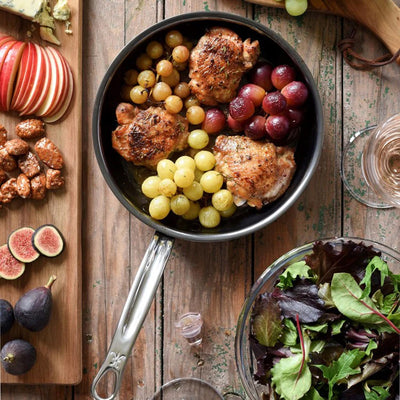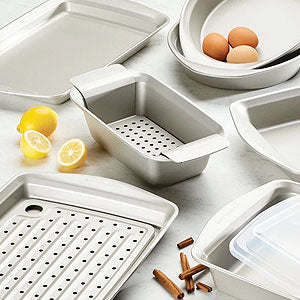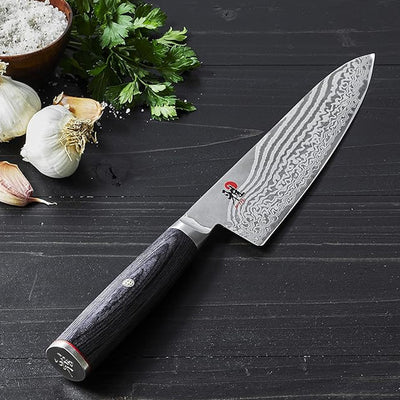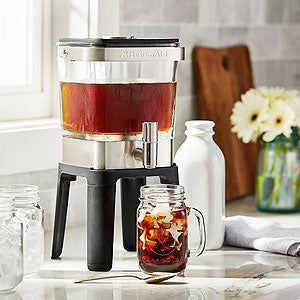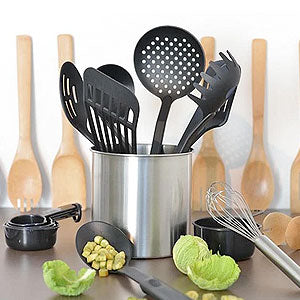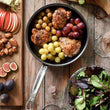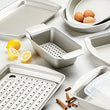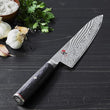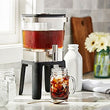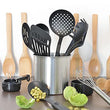Kitchen
French Cooking Terms and Techniques
Many people regard French cuisine as an exclusive form of cooking reserved for professional chefs and fancy restaurants. Au contraire. Learning a few basic French cooking terms and techniques will help you save time, prepare healthier and more flavorful meals, and take your enjoyment of cooking and dining to new levels. If you are an experienced home cook, you probably are familiar with many of these terms and skills. If you are a beginner, mastering these basics is well worth the effort. Improve your skills in the kitchen with this glossary of common terms and techniques.

Glossary of Culinary Terms
Au jus
A French culinary term meaning "with juice". It refers to meat dishes prepared or served together with a light gravy, or broth, made from the fluids secreted by the meat as it is cooked.
Au Gratin or Gratiner
To sprinkle the surface of a cooked food such as vegetables or seafood with bread crumbs and butter, and sometimes cheese, and then brown under the broiler. The finished food is referred to as au gratin as in au gratin potatoes.
Bain-marie
A type of roasting pan or baking dish partially filled with water to allow food to cook more slowly and be protected from direct high heat. Used for custards and terrines.
Bavarois
A dessert custard made with gelatin, eggs, and whipped cream.
Béchamel
A white sauce made from a white roux and milk. It is often used as the base for other sauces.
Beignets
Beignets are small dollops of dough that are fried called fritters.
Beurre Manié
A dough, consisting of equal parts by volume of soft butter and flour, used to thicken soups and sauces.
Beurre Noisette
Browned butter used as a type of warm sauce.
Bisque
A smooth, creamy, highly seasoned soup based on a strained broth of crustaceans such as lobster, langoustine, crab, shrimp, or crayfish.
Blanquette
A stew made from meat such as lamb, chicken, or veal that has not been browned or fried in the cooking process.
Bouchées
Small puff pastry cases with a sweet or savory filling.

Bouillon
A broth or stock made by stewing meat, fish, or vegetables in water.
Bouquet Garni
French for a “garnished bouquet”, this is a mixture of fresh herbs encased in a cheesecloth bag and tied together with string and used to flavor stews, soups etc. It usually is a mix of parsley, bay leaf, thyme (and sometimes celery stalk). The bouquet is removed before serving.
Brunoise
Finely diced vegetables that are cooked in butter and used to flavor sauces and soups.
Canapé
An appetizer consisting of a small bread or biscuit base covered with a savory topping and usually served with drinks at a reception or formal party.
Chapelux
Browned bread crumbs.
Charcuterie
Charcuterie is a branch of cooking that specializes in prepared meat products. It also refers to a presentation of a variety of meats and cheeses and often fruit or nuts typically served on a wooden board.
Chine
To cut along the backbone in a cut of meat or to remove the backbone from a rack of ribs.
Concasser
To crush, grind, or rough chop any ingredient, particularly vegetables.
Consommé
A type of clear soup made from richly flavored stock, or bouillon that has been clarified, a process that uses egg whites to remove fat and sediment.
Coulis
A thin fruit or vegetable puree, used as a sauce.
Court Bouillon
A quickly-cooked broth used for poaching other foods, most commonly fish, seafood, vegetables, or delicate meats.

Crêpes
Very thin pancakes that served with a variety of garnishes or fillings, usually sweet or savory.
Croquettes
A mixture of potato with ground cooked meat, fish or poultry formed into balls, patties or other shapes, which is breaded and deep fried. Croquettes are served as a side dish, snack, or fast food.
Croustade
A piece of bread or pastry that hollowed to receive a filling, dipped in butter, and baked until it is crisp.
Croûte
Sometimes refers to a piece of toasted bread or a pastry crust on which savory snacks can be served.
Croûtons
Small cubes of toasted bread used as a garnish is salads and soups. Come in plain or seasoned varieties.
Dariole
Small mold shaped like a castle used for molding salads or baking cakes.
Déglacer
A cooking technique for removing and loosening browned juices and fat from the bottom of a frying pan or saucepan by adding liquid, bringing to a boil, and stirring. The liquid is usually water, wine or broth.
Dégorger
To extract juices from meat, fish or vegetables, usually by salting them, then soaking, or washing. It is usually done to remove a strong taste.
Dépouiller
To skim off the fatty layer or “skin” that accumulates at the top of a stock or sauce.

Demi-glace
A rich brown sauce in French cuisine used by itself or as a base for other sauces.
Duxelles
A preparation of finely chopped mushrooms sautéed with onions, shallots, garlic, and parsley and used to make stuffing or sauce.
Entrecôte
A premium cut of beef used for steaks, traditionally cut from the rib area (similar to ribeye).
Entrée
The term used to refer to something served before the main course but is used now to refer to the actual main course.
Entremets
Historically, these were small dishes served between servings. In modern times, it is a dessert or sweet, but not including pastries.
Escalops
A thin slice of boneless meat that is often pounded out to make it thinner.
Farce
Finely chopped and highly seasoned meat used as a stuffing.
Flamber or Flambé
A cooking procedure in which alcohol is added to a hot pan to create a burst of flames.
Frappé
Something that is iced or set on or in a bed of ice.
Fricassé
A method of cooking meat (typically poultry, meat, or rabbit) in which it is cut up and braised, and served with its sauce (usually a white sauce).
Glace de Viande
Reduced brown stock used to add color and flavor to sauces.

Hors d'Oeuvres
An appetizer or starter is a small dish served before a meal. Some are served hot and others are served cold.
Julienne
A julienne cut is used to prepare foods, usually vegetables, into small, uniform rectangles that look like matchsticks, and is used primarily for presentation purposes.
Jus or Jus de Viande
The meat juices that occur naturally from cooking.
Jus Lié
Meat juice that has been lightly thickened with a either arrowroot or cornstarch to form a gravy.
Liaison
Ingredients used for thickening sauces, soups, or other liquids.
Macédoine
Small diced mixed vegetables, usually containing at least one root vegetable. Sometimes also refers to a mixture of fruit, like fruit salad.
Marmite
French word for a covered potbelly shaped earthenware container for soup. The soup is both cooked and served in it.
Mirepoix
A mixture of braising vegetables.
Mise en place
A French term that literally just means “putting in place,” it refers to prepping and measuring your ingredients, putting them in bowls and containers to have ready to add as you prepare a recipe.
Mortifier
To hand render meat, game, or poultry.
Moulè-â-manqué
A cake tin that is wider at the base than at the top and only about 1" in depth.
Napper
To lightly coat food with a sauce so it completely covers the food with a thin even layer.
Noisette
The word literally means "nut". It can refer to chocolate made with hazelnuts or also to a small piece of lean meat, usually lamb that is rolled, tied and cut into rounds.

Nouvelle Cuisine
A term that refers to a modern style of cooking that avoids rich, heavy foods and emphasizes the freshness of ingredients and the presentation of the dishes.
Panade
A very thick mixture, consisting of stale bread boiled to a pulp in water or milk that is used as a base for dishes such as soufflés and fish cakes.
Paner
To coat with egg and crumbs before frying.
Papillote
A method of cooking in which food is wrapped in parchment paper around fish and then baked. The paper retains moisture in the food.
Parisienne
Refers to potatoes molded into balls with a melon scoop and fried or roasted.
Pâte
A basic mixture or paste. Often refers to uncooked dough or pastry.
Pâté
A paste, pie, or loaf consisting of a forcemeat that typically contains liver. Common additions include ground meat from pork, poultry, fish or beef, fat, vegetables, herbs, spices and either wine or brandy.
Pâtisserie
A term used to describe French pastries and the pastry shop they are sold in.
Piquer
To insert fat, bacon, ham etc. into meat or poultry.
Pot a feu
French beef stew made with beef, vegetables (carrots, turnips, leeks, celery, and onions), and a cartilaginous meat such as oxtail or marrowbone.
Poussin
A young chicken.
Quenelle
Minced fish or meat mixture, sometimes combined with breadcrumbs and a light egg binding, that is formed into small shapes and poached. It also refers to a shape that the minced mixture is made into.

Ragoût
A main dish stew of heavily spiced and seasoned vegetables with or without meat that is slow cooked over a low heat.
Réchauffée
A dish of food that has been warmed up or reheated.
Repere
Flour mixed with water or egg white and used to seal pans when cooking food slowly. Often used when cooking a ragoût.
Revenir
To quickly fry meats or vegetables in hot fat to warm them through.
Roux
Flour and fat (usually melted butter) that has been cooked together. Used as a thickener for sauces or soups.
Rouille
A Provençal sauce made from pounded red chilies, garlic, breadcrumbs, and other ingredients blended with stock, typically added to bouillabaisse.
Sauté
To fry quickly in a little hot fat or cooking oil.
Sautoir
A deep frying pan with a lid, used for recipes that require fast frying, then slow cooking.
Terrine
A meat, fish, or vegetable mixture that has been baked or steamed in a covered pottery mold then allowed to cool or set in its container, typically served in slices.
Timbale
A dish of finely minced meat or fish cooked with other ingredients in a pastry shell or in a mold.
Velouté
A rich white sauce made from butter, flour, cream and chicken veal, pork, or fish stock.
Vol-au-vent
A small hollow case of puff pastry that is usually used as a container for creamed dishes, such as creamed chicken.

Cooking Techniques to Master
A key to mastering French culinary techniques is to learn the basic cooking methods used by chefs. Every home cook should know these basic, but important cooking skills which will translate well for preparing dishes from a variety of cuisines. Learn one technique and others will follow until you are enjoying preparing delicious and healthy meals and cooking with flair.
Baking
Baking is a method of preparing food that uses dry heat, normally in an oven, but can also be done in hot ashes, or on hot stones. All types of foods can be baked with some requiring more steps and care than others. Baking is used to prepare cured meats such as ham, meatloaf, casseroles, breads, cakes, pastries, pies, tarts, quiches, cookies, sconces, crackers, and much more. Using specialized bakeware designed for the particular food or dish will help you achieve the best results.
Blanching
Blanching is a cooking process in which a food, typically vegetables or fruit, is scalded in boiling water, removed after a brief, timed interval, and finally plunged into iced water or placed under cold running water to halt the cooking process. The three stages of the process include preheating, blanching, and cooling. Blanching helps to preserve color, flavor, and nutritional value. Blanching also helps remove pesticide residues and decrease microbial load. Blanching requires a large pot for boiling or steaming along with a strainer, wire basket, or blancher insert along with a bowl or container for ice water.
Braising
Braising is a combination-cooking method that uses both wet and dry heats and follows the same basic steps whether you are braising meat, vegetables, mushrooms, etc. Food is first pan-seared to brown its surface and enhance its flavor. For foods that do not produce enough liquid on its own during the cooking process, some cooking liquid such as tomatoes, beer, vinegar, or wine is added to the pot along with stock. The dish is then covered and simmered on low until the food is tender and easy to cut. Cooking liquid is often finished to create a sauce or gravy. Special pans called braisers or braising pans are best used for this process.

Broiling
Broiling is cooking by exposing food to direct radiant heat, either on a grill over live coals or below a gas burner or electric coil. The process differs from roasting and baking in the oven in that the food is turned during broiling to cook one side at a time. Broiling requires a grill or a broiling pan to be used in your oven.
Flambéing
Flambéing is a cooking procedure in which alcohol is added to a hot pan to create a burst of flames. The process is usually associated with a the presentation of certain dishes set aflame such as Bananas Foster, but it is also a step used while preparing other dishes such as coq au vin. You can use a fry pan, sauté pan, a braiser, or even a Dutch oven.
Poaching
Poaching is a gentle and effective method of cooking using some form of liquid and heating at a low temperature. It’s ideal for cooking delicate proteins such as eggs, fish, and chicken, as well as some vegetables and fruit. It uses a lower temperature than simmering and a shorter cooking time which allows the proteins in the food to break down without pulling moisture out of the food. The liquid used can be broth, wine, water, or even sometimes milk. Poaching is typically done in a fry pan or a sauté pan.
Sautéing
To sauté is to lightly fry foods in a small amount of oil or hot fat at a high temperature. In order to saute effectively, you need to keep the ingredients moving about by shaking the pan, flipping ingredients, or constantly stirring and swirling the ingredients as they cook to prevent sticking and ensure even browning. A sturdy sauté pan with a wide bottom and straight sides is the ideal pan to use for the task.

